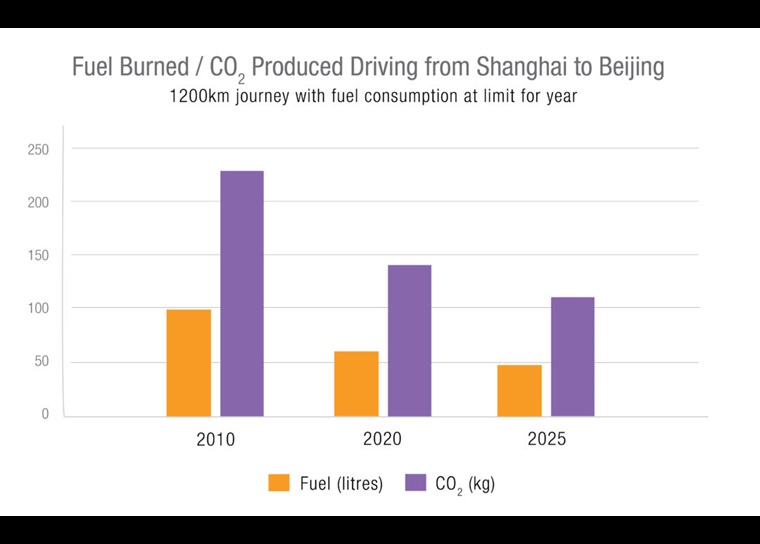Feb 28, 2019
Posted by Keith Howard, Strategic Technology Manager, Ping Zhu, Director of Technology, Asia
The stringent China 6 emissions limits that are about to be implemented across the country are matched by equally tough fuel economy requirements for both passenger cars and commercial vehicles. Every year sees a tightening of fuel consumption limits, meaning that vehicles sold in China are now on a par with any in the world in terms of efficiency.
The corporate average fuel consumption (CAFC) limit for passenger cars is dropping from 8.2 l/100km in 2010 to 5.0 l/100km in 2020, and then 4.0 l/100km in 2025. To illustrate the effect of this in practice, a drive from Shanghai to Beijing in a car at the 2010 limit would burn 98 liters of gasoline and produce around 230 kilos of CO2, but in 2025, that will drop by more than half to just 48 liters and 110 kilos respectively (also saving the driver around 335RMB or $50 based on current fuel prices in February 2019). If you consider this across the huge and growing car population in China, the reduction is staggering – in 2020, there will be a saving of around 160 billion liters of fuel (over a trillion RMB) and 370 million tons of CO2 every year.

The adoption of plug-in hybrids and battery electric vehicles will contribute to reducing China’s fuel consumption, and is encouraged with incentives for both manufacturers and consumers. Such incentives are a significant factor in the booming electric vehicle market in China.
For heavy duty vehicles, the phase III regulations due for introduction in July 2019 set limits which are tiered according to gross vehicle weight, but will equate to an overall 15% reduction in fuel consumption compared to the previous regulations. Fuel makes up most of the operating costs for a commercial fleet owner, so such a saving has a massive impact on the profitability of the operation. For example, the difference between phase II and phase III fuel consumption for a fleet of 20 heavy duty trucks covering 75,000km per year each would be a fuel cost saving of around 900,000RMB or $130,000 per year.
To meet the aggressive fuel economy targets, OEMs continue to innovate for more efficient powertrain hardware. Turbocharging and direct injection have become the norm for passenger car gasoline engines, while heavy duty diesel engines have increased in both power output and efficiency. For the driveline, there has been a drastic increase in hardware options in recent years: More gears for manual and automatic transmissions, increased adoption of continuously variable transmissions (CVTs), dual clutch transmissions (DCTs) and more recent development of e-transmission and e-axles, while at the same time moving to smaller sumps with increased power density.
For both engine and driveline lubricants, the challenge is providing fuel economy whilst protecting the hardware under often severe operating conditions and an extended oil drain interval (ODI). Driveline lubricants in particular have extremely long drain intervals and are often filled-for-life. Viscosities of lubricants in China have dropped rapidly, and in many cases are now equal to those in Europe and North America.
Long ODI and lower viscosityA measure of a fluid's resistance to flow. A fluid with a higher viscosity flows less easily. both require enhanced protection. Our work outside and inside China has shown it is possible to maintain durability while improving efficiency using high performance lubricants that are formulated with high quality base oils, shear stable viscosity modifiers and more robust additive technology to compensate for lower viscosities and provide performance reserves to protect throughout the intended drain interval.
The importance of fuel quality will inevitably increase with the need for reduced fuel consumption. Fuels must work effectively with the more stressed and sophisticated vehicle hardware necessary for lower emissionsMobile sources - Pollutant exhaust gases created by the combustion of fuel. Water and CO2 are not included in this category, but CO, NOx, and hydrocarbons are and are thus subject to legislative control. All three are emitted by gasoline engines, while diesel engines also emit particulates that are regulated. Stationary sources - The release of sulfur oxides and particulates from power stations that can be influenced by fuel composition. Local authorities control the sulfur content of heavy fuel oils used in such applications. limits and improved efficiency, and therefore must be formulated with optimal properties. Additionally, there is an increasing need to sustain this over the vehicle’s lifetime to avoid onboard diagnostics (OBD) error codes and comply with long-term emissions durability limits. The importance of deposit controlling fuel additives will increase.
We can see that China’s plans for major reductions in fuel consumption, in parallel with the introduction of stringent emissions legislation, are having a significant impact on the lubricants and fuels used in the growing vehicle population. A major upgrade in performance is required to provide lower fuel consumption whilst protecting more complex, powerful hardware. We will give some more detailed insights into how this can be achieved in some of the later articles in the series.
 If you would like additional information on China 6, visit the China 6 section, or contact your Lubrizol representative
If you would like additional information on China 6, visit the China 6 section, or contact your Lubrizol representative









